Fishing the Bill Lewis Rat-L-Traps
Fishing the Bill Lewis Rat-L-Traps
Written by Tommy Martin Retrieves There are many different ways to work a Rat-L-Trap and using the right presentation can improve your day’s catch. Here are three of the very best techniques for Trap fishing. Burn It 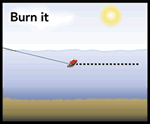 This is by far the most popular method, a fast steady retrieve covering a lot of water. Many professional fishermen use this method and they call it “locating”. It will allow you to make a lot of casts in a short period of time, thus improving your chance of finding an area where fish are holding. This is an early spring favorite for covering shorelines were bass are spawning. Once you catch a fish, stay in that area and really give it a good work over. You most likely will pick up a couple of more fish in a short period of time. A high-speed reel is highly recommended when burning a Trap. Most reels today come with 5.3 to 1 ratios and are sufficient for this method. However a 6 to 1 ratio is better on your arm. This is by far the most popular method, a fast steady retrieve covering a lot of water. Many professional fishermen use this method and they call it “locating”. It will allow you to make a lot of casts in a short period of time, thus improving your chance of finding an area where fish are holding. This is an early spring favorite for covering shorelines were bass are spawning. Once you catch a fish, stay in that area and really give it a good work over. You most likely will pick up a couple of more fish in a short period of time. A high-speed reel is highly recommended when burning a Trap. Most reels today come with 5.3 to 1 ratios and are sufficient for this method. However a 6 to 1 ratio is better on your arm. Stop & Go 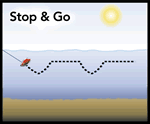 When you reel in a Trap, slow or fast, stop the reel every 3 or 4 cranks of the reel handle. This will cause the lure to fall for a second simulating an injured baitfish. You can experiment with this technique by changing up the rhythm of your pause. This is a perfect technique to use where there is a target to throw at. If there is a laying log or a dock, run the Trap up to the log and pause the bait before and after the structure. You don’t need much of a pause; just a split second will allow the bait to fall a little. Be ready at that point, that’s usually when the strike will occur. Bill Lewis uses this method often; it’s one of his personal favorites. When you reel in a Trap, slow or fast, stop the reel every 3 or 4 cranks of the reel handle. This will cause the lure to fall for a second simulating an injured baitfish. You can experiment with this technique by changing up the rhythm of your pause. This is a perfect technique to use where there is a target to throw at. If there is a laying log or a dock, run the Trap up to the log and pause the bait before and after the structure. You don’t need much of a pause; just a split second will allow the bait to fall a little. Be ready at that point, that’s usually when the strike will occur. Bill Lewis uses this method often; it’s one of his personal favorites. YO-YO 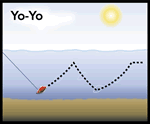 Up and down, a very effective technique for deeper water presentations. Using your rod tip to make the lure rise and fall over structure. Keep in mind a Rat-L-Trap will fall at the rate of 1 1/2 ft per second. This will help you count the lure down to a certain depth. A good example is suspended fish at 15 feet on a graph. You could count to 10 and the Trap will most likely be right in the zone for a strike. If a school is holding in deep water of a major point, try the technique and cover both sides of the point. It really helps if you know the depth of water on each side. If you’re in 20 foot of water, you may want to Yo-Yo the Trap from 5 to 15 feet. Remember, the size of your line will effect how fast a lure sinks. Heavy line will slow the fall rate down and small diameter will speed it up. Up and down, a very effective technique for deeper water presentations. Using your rod tip to make the lure rise and fall over structure. Keep in mind a Rat-L-Trap will fall at the rate of 1 1/2 ft per second. This will help you count the lure down to a certain depth. A good example is suspended fish at 15 feet on a graph. You could count to 10 and the Trap will most likely be right in the zone for a strike. If a school is holding in deep water of a major point, try the technique and cover both sides of the point. It really helps if you know the depth of water on each side. If you’re in 20 foot of water, you may want to Yo-Yo the Trap from 5 to 15 feet. Remember, the size of your line will effect how fast a lure sinks. Heavy line will slow the fall rate down and small diameter will speed it up. Size Selection Down sizing or up-sizing your lure can make a big difference in your success any given day. One of the most obvious reasons to change the size of a lure is to “match the hatch”. Pay close attention to the size of the prey the bass are feeding on. Shad come in all sizes and bass will gorge on them. If the shad are large, go to a lure close to that size, and vice versa. Another situation, when size matters, is when weather conditions change. I’ve seen times where a 1/2 oz Trap was working great early in the morning, and a cold front passed through and shut things down fast. The bite went sluggish, as they say. 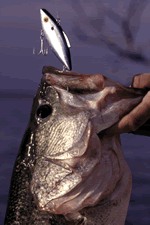 By going to a larger Trap I was able to slow the lure down and give the fish a bigger target. The fish also moved into a little deeper water and the larger lure naturally dropped quicker. It’s the perfect scenario for big baits. By going to a larger Trap I was able to slow the lure down and give the fish a bigger target. The fish also moved into a little deeper water and the larger lure naturally dropped quicker. It’s the perfect scenario for big baits. Now on the opposite note, going to a smaller lure can also improve your catch. I was fishing a tournament a few years back and the fish were bunched up on a rock jetty - feeding on small shad. I first tied on a 3/4 oz Trap but quickly found out there was rock all the way down—keeping me in the rocks instead of in the fish. I also noticed that they busted the shad as the current pushed them along the jetty. The bass weren’t really feeding on top; they were gorging on them just underneath the surface along the rocks. I tied on a 1/4 oz Chrome Rat-L-Trap and by keeping my rod tip up, I was able to rip the lure along the surface—dropping the lure into the frenzy with my rod tip. So remember, the next time you’re out and they get off a lure that was catching fish, don’t be so quick to change the type of lure. Instead go to a different size and you just may be surprised by the results. Well, we all asked for it and the lure companies gave it to us. I’m talking about all the different colors lures come in today. How many of us have called lure companies and said. “If you would just add a little green on the back, this lure would kill em.” We are all guilty. The truth is that we do need a good selection of colors and, they are fun in the tackle shop. However, with a few tips you can keep it fairly simple. Spring
It’s probably the best time for big bass because of the spawn. Springtime means the water is warming and so is the atmosphere. And that usually means showers and rising water. Most reservoirs will get a little extra water from rising creeks and rivers. This will muddy things up a little, so now is the time to use bright colors and noisy lures. I like using Traps in crawfish patterns in bright red and orange for the early bite. Many of the lakes are full of crawfish, a favorite snack for big bass. Remember bass are opportunist and crawfish are slow and easy to feed on. Keep in mind the Louisiana mudbugs can get real big and the bigger they are, the more color they put on. When working the banks in the spring, you can’t beat a Rat-L-Trap. It’s easy to cast and will cover a lot of water quick. A Trap and a spinnerbait can do a lot of damage in a short time. My favorite color for shallow water is chartreuse or bright green. 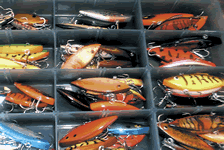 Here’s why. Have you ever taken time to notice how many small bream and perch are under docks and around the banks of any lake? The majority of them will fall into the yellow or green perch family. It’s an endless food supply for any predator. If you catch one and look closely you can see on the tips of the scales highlights of green and chartreuse. That’s why chartreuse and white colors work so well in the spring. Here’s why. Have you ever taken time to notice how many small bream and perch are under docks and around the banks of any lake? The majority of them will fall into the yellow or green perch family. It’s an endless food supply for any predator. If you catch one and look closely you can see on the tips of the scales highlights of green and chartreuse. That’s why chartreuse and white colors work so well in the spring. A good tip to remember is that bait in shallow water are a little harder to catch and usually move quickly to avoid being eaten. Using a faster retrieve can trigger more strikes. Summer
Get ready for things to slow down. With the water warming, fish will try to find a constant temperature zone. Points or flats that are close to deeper water offer great holding areas for bass. It also gives them a great ambush point for unsuspecting shad that raft over the edge. Take notice of where the eyes are located on all predator fish...towards the top of their head. They can see everything that moves above them. Bass can lay and wait off a deep point and rocket to the surface in a split second to bust the school into oblivion. It’s a perfect scenario for a Rat-L-Trap. Cast beyond the point and bring it across, then let it fall for a few seconds. I’ve caught a lot of fish like that. There are three colors that work well in this situation; chrome, chrome, and chrome. More fish have been caught on a Chrome Blue Back Rat-L-Trap than any other lure I can think of. It’s the no brainer. It’s kind of an old saying. “If nothing else works, tie on a Chrome Trap”. I’ve heard this on the circuit all of my life and it still stands true today. It’s the go-to bait for a lot of fishermen. Fall
Cold fronts and cooler temperatures usually mean feeding frenzy prior to the front passing through. It’s nature’s dinner bell. Usually bass will “stock up” or gorge to protect themselves from long periods without abundant food. When water temperature starts to fall, fish react much like a bear prior to hibernation. The main source of food is still shad. However, the water is now super clear from the lack of substantial rain during late summer. Shad will start to take on a different hue with sunlight penetrating the clear water. They will appear to have some blue, green, brown, and even red tints in their scales. Rat-L-Trap offers the perfect color series for this bite. They are shad patterns with variations of colors on the sides of lure and have white bellies with markings like a shad. These natural patterns are perfect for this time of year. It’s been my experience that light colors like pearl, bone, and white are also good producers in clear water. Winter
Clean your boat, reels, camp, and spend lots of time with your bride. Not necessarily in that order.
Click here to view the full line of Bill Lewis Rat-L-Traps. Article is courtesy of the Bill Lewis Website, view their site for other information about the baits.
Bill Lewis Lures
|
